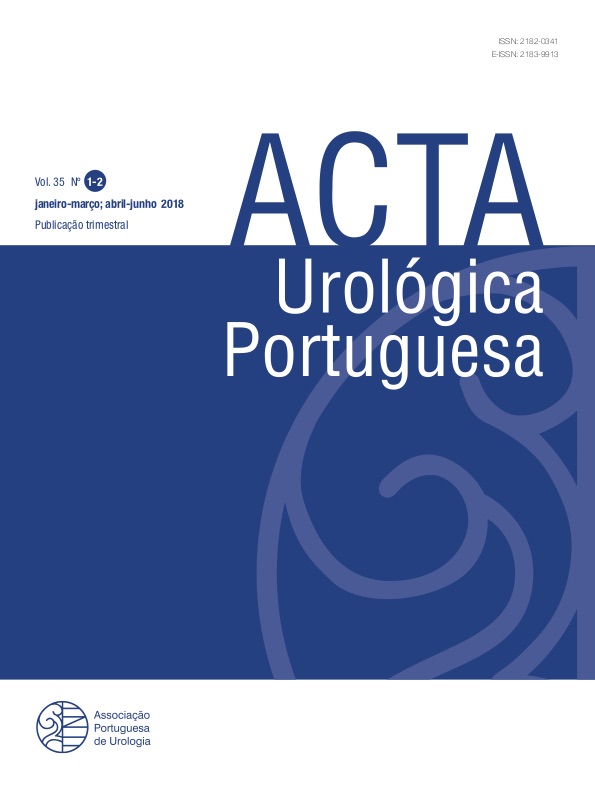Urinary Tract Infections of Faial Island Community, Determined in Hospital da Horta EPER - 2016
DOI:
https://doi.org/10.24915/aup.35.1-2.47Keywords:
Urinary Tract Infections/microbiology, Urinary Tract Infections/drug theraphy, Drug Resistance, Bacterial, Azores, Anti-Bacterial AgentsAbstract
Introduction: Urinary tract infection (UTI) is one of the most frequent infections at community level, presenting higher costs for society and health system. The publication of epidemiological evaluation studies of etiological agents responsible for UTI and its antimicrobial resistance profile is an added value for the elaboration of decision criteria for antibiotic- empirical therapy, serving as well to alert the health professionals for the benefits of a correct antimicrobial prescription.
Material and Methods: Cross-sectional epidemiological study, based on the urine cultures performed to external users of the Clinical Pathology Service of Horta Hospital EPER in the year 2016. On the urine cultures considered positive, parameters such as age, sex, type of bacteria and antimicrobial susceptibility profile were study. All records with insufficient data for analysis, as well as all requests for duplicate urine cultures from the same patient within a period of less than 7 days, were excluded from the study. All the data used were provided by the Clinical Pathology Service of the Horta Hospital EPER.
Results: Higher prevalence of positive urine cultures in women compared to men. In women, a bi-modal trend with the first peak occurring in the age group of 30 to 39 years, the second (highest) peak in the 70-79 age group. In men, the tendency to increase occurs beginning from the age group of 50 to 59; the frequency of bacteria isolated between sexes were different. The prevalence of Escherichia coli (major responsible for UTI) in women is higher than in men. The second and third most frequent bacteria were Klebsiella p. Pneumoniae and Proteus mirabilis respectively, with higher frequency in man than in woman in both cases; Major frequency of ESBL occurred in man; the study of antimicrobial profile in Escherichia coli strains showed high sensitivity to fosfomycin (>95%) and nitrofurantoin (>95%). Trimethoprim/ sulfamethoxazole and fluoroquinolones showed high resistance (close to 20%). Amoxicillin and amoxicillin/clavulanic acid with much higher resistance when compared to fosfomycin and nitrofurantoin. Excluding cephalothin, there were some heterogeneity in the cephalosporin group, but with sensitivities always higher than 80%.
Conclusion: This type of studies helps to determine the guidelines for an empirical antibiotic therapy.
Downloads
References
2. Foxman B. The epidemiology of urinary tract infection. Nature Rev Urol. 2010; 7: 653–60.
3. Flores-Mireles AL, Walker JN, Caparon M, Hultgren SJ. Urinary tract infections: epidemiology, mechanisms of infection and treatment options. Nat Rev Microbiol. 2015;13:269-84.
4. INSA- PNCI. CRITÉRIOS DO CDC PARA O DIAGNÓSTICO DAS INFECÇÕES. [Acedido 12 Fevereiro, 2017]. Disponível em: https://www.dgs.pt/criterios-da-definicao-de-infeccao-do-cdc-2003-pdf.aspx
5. Direção Geral da Saúde. Terapêutica de infeções do aparelho urinário (comunidade). Norma nº 015/2011. [Acedido 02 Fevereiro de 2017]. Disponível em: https://www.dgs.pt/directrizes-da-dgs/.../norma-n-0152011-
de-30082011-jpg.asp
6. Kahlmeter G. Prevalence and antimicrobial susceptibility of pathogens in uncomplicated cystitis in Europe. The ECOSENS study. Int J Antimicrob Agents. 2003; 22 Suppl 2:49-52.
7. Schito GC, Naber KG, Botto H, Palou J, Mazzei T, Gualco L, et al. The ARESC study: an international survey on the antimicrobial resistance of pathogens involved in uncomplicated urinary tract infections. Int J Antimicrob
Agents. 2009; 34: 407–3.
8. European Centre for Disease Prevention and Control. Antimicrobial resistance surveillance in Europe 2014. Annual Report of the European Antimicrobial Resistance Surveillance Network (EARS-Net). ECDC. [Acedido 02
Fevereiro de 2017]. Disponível em https://doi.org/10.2900/39777
9. Narciso A, Fonseca F, Cerqueira S, Duarte A. Susceptibilidade aos antibióticos de bactérias responsáveis por cistites não complicadas: estudo comparativo dos isolados de 2008 e 2010. Acta Urol. 2011; 28:16 – 21.
10. Silva A, Machado P, Rodrigues V, Duarte A. Bactérias uropatogénicas identificadas de cistites não complicadas de mulheres na comunidade. Acta Urol. 2008; 25: 9 – 14
11. Hooton TM. Pathogenesis of urinary tract infection: an update. J Antimicrob Chemother. 2000; 46 (S1): 1-7.
12. PORDATA. [Acedido 02 Fevereiro de 2017]. Disponível em: http://www.pordata.pt/Subtema/Portugal.
13. Marques T, Ribeiro D, Maia C, Santos H. Nascer é envelhecer: uma perspetiva demográfica evolutiva e territorial na construção do futuro de Portugal. Rev Geografia Ordenamento Território. 2016; 6: 207-31.
14. Gómez Ayala AE. Infección urinaria en el anciano. Farm Prof. 2009; 23:40–5.
15. Revisão dos Consensos em Infeções Vulvovaginais. Lisboa: Sociedade Portuguesa de Ginecologia; 2012.
16. Rolo, Francisco. 100 Perguntas sobre Hiperplasia Benigna da próstata. Associação Portuguesa de Urologia. [Acedido 02 Fevereiro de 2017]. Disponível em: http://www.apurologia.pt/pdfs/101P_HBP.pdf
17. aemann MD, Weichhart T, Horl WH, Zlabinger GJ. Tamm-Horsfall protein: a multilayered defence molecule against urinary tract infection. Eur J Clin Invest. 2005; 35: 227-35.
18. Dulawa J, Kokot F, Kokot M, Pander H. Urinary excretion of Tamm-Horsfall protein in normotensive and hypertensive elderly patients. J Hum Hypertens. 1998; 12: 635–7.
19. Rolo F, Parada B, Moreira P. Cistite não complicada na mulher: Guia multidisciplinar reconhecido pela Associação Portuguesa de Urologia. Lisboa: Associação Portuguesa de Urologia; 2008.




